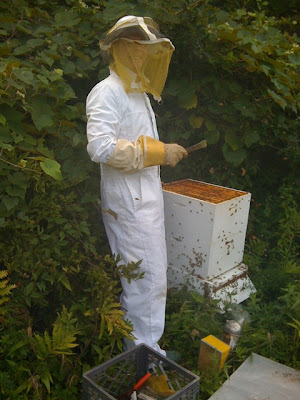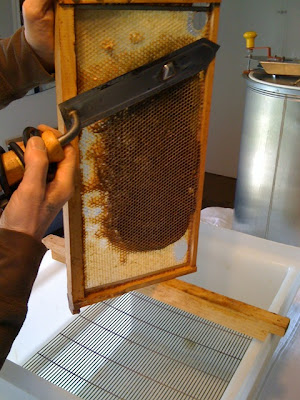We all probably have a jar of honey stored in our pantry, but have you ever stopped to consider what it actually took to get it there? A bottle of pure honey is produced naturally. Known by the Greeks and Romans as the Birds of the Muses, honeybees produce honey by gathering nectar, which they place in the honeycomb cells of their hive. Bees must tap approximately two million flowers to make one pound of honey. That sticky-sweet amber liquid enjoyed by humans for centuries is an all natural sweetener purported to contain restorative properties; if you can’t bottle it yourself you want to make friends with someone who does.
photo credits: Mark Bagg and Rick Rosabella

 |
Homespun honey from Bagg's Apiary,
New Milford, Connecticut |
Like gardens on city rooftops or chickens in a deserted tenement, bees can be kept almost anywhere. Bee “farmers”, mostly on the West Coast and in the Midwest here in the United States, move thousands of hives a year, assisting in the pollination of crops, helping to feed the world. We have all heard stories of hives in walls, or swarms in the unlikeliest of places; whether they live in glass-designed hives for your viewing pleasure, like the one at the White Memorial Conservation Center in Litchfield, Connecticut, or nest in an unwanted invasion of a home or outbuilding, bees are adaptable.
Here in New England you may pass multicolored stacks of bee “houses” in overgrown fields, or rows of pristine white boxes in the aisles of orchards. No matter their aesthetics, these towers are home to bees busily buzzing, feeding their colony, creating delicious honey.
The beautiful thing about bees is that they are perfect little machines operating in harmony with the earth’s ecosystem, and have been doing so for hundreds of thousands of years. They are tried and true producers of a healthy sweet, accomplishing this feat while not only NOT polluting their environment (and ours), but also assisting in the successful reproductive process of fruit and nut trees, vegetables, and the beautiful flowers we all love so much. I am sure there were bees in the Garden of Eden, or at least in the Land of Milk and Honey.
I love gardening and I love to share the fruits of that labor with family and friends. Being able to share the additional benefit of homespun honey would simply sweeten the pot for us all. Bottling our own honey hasn’t happened yet for two reasons: one – we just gained access to a hive last summer and it takes a year to establish a colony and be able to harvest; and two – we haven’t collected all the equipment or expertise required to get that savory liquid gold into the pretty little bottles we are collecting, but we will. In the meantime, our friend and bee keeper, Mark Bagg of New Milford, Connecticut, is tutoring us in the ways of the honeybee. This is what we have learned so far.
 |
| Mark Bagg, Bee Keeper |
Bee hives are made so that their frames are easily removed, which is good news for those doing the harvesting. Modern beehives are made up of a series of square or rectangular boxes without tops or bottoms placed one on top of another. Inside the boxes, parallel frames are hung in which bees build up the wax honeycomb where they store honey. A comb is ready to be harvested when it’s about 80% sealed over. Ripe honey, when removed properly from the hive by the beekeeper, has a long shelf life and will not ferment. Mark tells me archaeologists recovered honey from the Tombs of the Pharaohs, and while it had crystallized it was still edible.
Basic tools and procedures for extracting honey:
Uncapping knife - A heated knife for slicing off the cappings from combs of honey.
Uncapping tank - A container for receiving the cappings. Wet cappings fall onto a screen, and honey drips through to the bottom of the tank and out a spigot.
Extractor - A drum containing a rotating wire basket. Uncapped combs are placed in the basket and the basket is turned by hand or by motor. Centrifugal force removes the honey from the combs onto the sides of the tank, eventually draining through a spigot in the bottom. Emptied combs can be returned to the hive for the bees to clean and use again. With care, combs can be recycled for years.
 Strainer - A mesh of coarse screen or cloth directly under the extractor spigot. This filters out large debris such as wax.
Strainer - A mesh of coarse screen or cloth directly under the extractor spigot. This filters out large debris such as wax.
Storage tank - A large tank with a spigot, or "honey gate," at the bottom. As honey settles in the tank, air bubbles and small debris rise to the top and can be skimmed off, allowing honey that is bottled from the honey gate to be clear and attractive.
So there you have it. The very basics of beekeeping, but like I said if its something you can't do yourself you can still enjoy local bottled honey anytime of year. Use it in your tea, on toast with butter, use it when baking instead of sugar. Honey, an all-natural sweetener, and that's hard to beat!
Uncapping knife - A heated knife for slicing off the cappings from combs of honey.
Uncapping tank - A container for receiving the cappings. Wet cappings fall onto a screen, and honey drips through to the bottom of the tank and out a spigot.
Extractor - A drum containing a rotating wire basket. Uncapped combs are placed in the basket and the basket is turned by hand or by motor. Centrifugal force removes the honey from the combs onto the sides of the tank, eventually draining through a spigot in the bottom. Emptied combs can be returned to the hive for the bees to clean and use again. With care, combs can be recycled for years.
 Strainer - A mesh of coarse screen or cloth directly under the extractor spigot. This filters out large debris such as wax.
Strainer - A mesh of coarse screen or cloth directly under the extractor spigot. This filters out large debris such as wax.Storage tank - A large tank with a spigot, or "honey gate," at the bottom. As honey settles in the tank, air bubbles and small debris rise to the top and can be skimmed off, allowing honey that is bottled from the honey gate to be clear and attractive.
So there you have it. The very basics of beekeeping, but like I said if its something you can't do yourself you can still enjoy local bottled honey anytime of year. Use it in your tea, on toast with butter, use it when baking instead of sugar. Honey, an all-natural sweetener, and that's hard to beat!



No comments:
Post a Comment